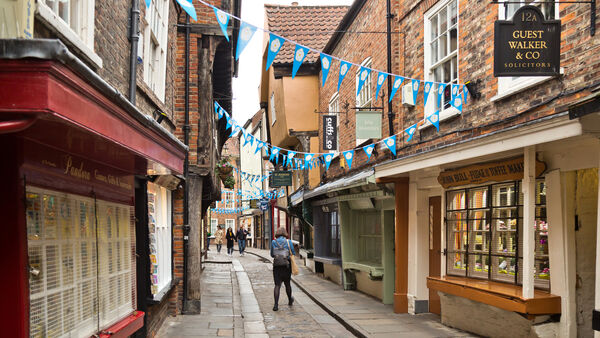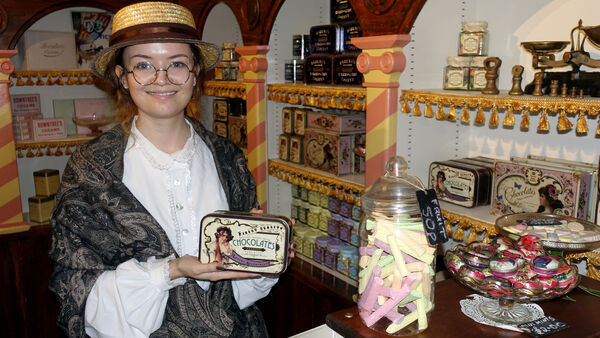York: A Time Travel Experience into Old England
England's York offers fascinating historic sights from a range of eras, nestled within the medieval walls an easygoing, walkable town.
By Rick Steves

We may have New York, but England has old York, one of the country's top tourist destinations outside of London. The town offers a captivating tour of historic sights mixed with an easygoing pedestrian ambience — all lassoed within its formidable medieval wall.
York has a rich, long history, serving as a Roman provincial capital in AD 71, capital of the Anglo-Saxon kingdom of Northumbria after the fall of Rome, and as a trading center called Jorvik from the 9th through the 11th century. Like counting the rings in a tree trunk, you can count the ages of York by the different bricks in the city wall: Roman on the bottom, then Danish, Norman, and the "new" addition — from the 14th century.
Later, Henry VIII used the city's fine cathedral as the northern headquarters of his Anglican Church. The huge York Minster is still a power center of the Church, and easily the town's top sight — but much more lies beyond. The minster's stately Gothic towers serve as a navigational landmark as you explore the town — or you can follow the strategically placed signposts, which helpfully point out all places of interest to tourists.
While only traces are left of most Viking settlements, "Jorvik" was an archaeologist's bonanza, the best-preserved Viking city ever excavated. When the archaeologists were finished, the dig site was converted into the Jorvik Viking Centre. Visitors ride a "Pirates of the Caribbean"-type people-mover through a re-created Viking street, complete with jabbering animatronic characters. The ride then rolls through the actual excavation site — the time-crushed remains of a once-bustling town. While innovative in 1984, Jorvik seems gimmicky today.
For straightforward Viking artifacts, beautifully explained and set in historical context with no crowds, tour the nearby Yorkshire Museum. Built into the ruins of what was once northern England's wealthiest abbey, the museum includes exhibits that tell the story of life here for the monks, how that all ended, and much more. The ancient Roman collection includes slice-of-life exhibits from cult figurines to the skull of a man killed by a sword blow to the head — making it graphically clear that the struggle between Romans and barbarians was a violent one. York soldiered on, amassing a large collection of weaponry throughout the ages. One of the museum's highlights is an eighth-century Anglo-Saxon brass helmet.
Nearby, the York Castle Museum is an old-school, sedate Victorian home show. English memorabilia from the 18th, 19th, and early 20th centuries are cleverly displayed in a huge collection of craft shops, old stores, and bygone living rooms.
As towns were being modernized in the 1930s, the museum's founder, Dr. Kirk, recognized the need to preserve elements of English heritage before they disappeared entirely. He collected entire shops and reassembled them here. On Kirkgate, the "street" that's the museum's most popular section, you can wander through life-size recreations of a Lincolnshire butcher's shop, bakery, coppersmith, toy store, and barbershop.
The shops are stocked with the actual merchandise of the day. In the confectionery, I once eavesdropped on English grannies giggling and reminiscing their way through the mouthwatering world of "spice pigs," "togo bullets," "humbugs," and "conversation lozenges."
Just outside the city walls, near the train station, is the National Railway Museum, showing two centuries of British railroad history. In the Industrial Age, York was the railway hub of northern England — and when it was built, York's station was the world's largest. The museum hosts an array of beautifully preserved historic trains fanning out from a grand roundhouse. A steam engine is sliced open, showing cylinders, driving wheels, and a smoke box in action. Exhibits trace the evolution of steam-powered transportation from very early trains like an 1830 stagecoach on rails to the aerodynamic Mallard — famous as the first train to travel at two miles per minute, a marvel back in 1938.
The focal point of York's half-timbered town center is the medieval butchers' street called The Shambles, with its rusty old hooks hiding under the eaves (the street's name is derived from "shammell" — a butcher's cutting block). Six hundred years ago, bloody hunks of meat hung here, dripping into the gutter that still marks the middle of the lane. This slaughterhouse of commercial activity gave our language a new word. And what was once a "shambles" is now a busy Tudor lane of tourist shops.
To get away from the bustle, linger at one of York's fine upscale bistros or elegant teahouses. Or try the two-mile walk along the Ouse River and over the handsome Millennium Bridge. If you follow the riverside tow path back into town, with your sights set on the mighty Minster towers, you may find yourself contemplating how a better understanding the story of this intriguing city makes it even more rewarding to visit.

